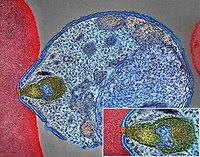
Photo from wikipedia
Eradications of invasive species are usually expensive and difficult to conduct. Knowing when to declare an eradication successful requires distinguishing between failed detection of the target species due to imperfect… Click to show full abstract
Eradications of invasive species are usually expensive and difficult to conduct. Knowing when to declare an eradication successful requires distinguishing between failed detection of the target species due to imperfect sensitivity of the detection method and true species absence. This is difficult because the sensitivities of many detection methods are unknown. Environmental DNA (eDNA) methods can be used to detect species by analysing DNA present in environmental samples. eDNA has been promoted as a particularly sensitive and cost‐effective way to detect species at low densities and, importantly, the sensitivity of eDNA surveys can be quantified. Nevertheless, the effort and costs involved in detecting species at extremely low densities, such as required during eradication, have not been previously calculated. We evaluated the sensitivity of eDNA surveys in detecting the invasive European carp, Cyprinus carpio, in two lakes in Tasmania, Australia, one in which carp have been eradicated and a second in which carp are currently being eradicated. We determined the sampling effort and associated cost required to detect the species at very low density in these lakes. While our eDNA survey detected the current low density carp population present in Lake Sorell, we show that an exponential increase in sampling effort and associated cost will be required to confidently detect the species as the population declines. Similarly, while our eDNA survey corroborated the species absence from Lake Crescent, our detection confidence was low. We quantify the survey effort and financial investment required to confidently establish eradication success in Lake Crescent. Synthesis and applications. Estimating the environmental DNA (eDNA) survey effort and cost required to detect species at a given density will enable practitioners to make informed decisions on the feasibility of implementing such surveys. Quantifying the sensitivity of eDNA surveys will also inform the confidence practitioners should place in eDNA detection results to ensure appropriate management actions are implemented and provide a suitable stopping point at which to confidently declare eradication success.
Journal Title: Journal of Applied Ecology
Year Published: 2019
Link to full text (if available)
Share on Social Media: Sign Up to like & get
recommendations!